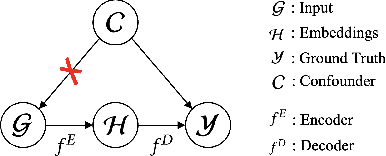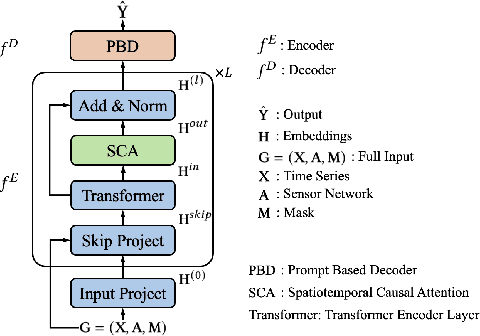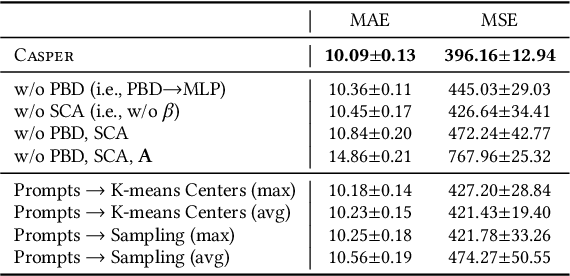Kan Ren
Linking Process to Outcome: Conditional Reward Modeling for LLM Reasoning
Sep 30, 2025Abstract:Process Reward Models (PRMs) have emerged as a promising approach to enhance the reasoning capabilities of large language models (LLMs) by guiding their step-by-step reasoning toward a final answer. However, existing PRMs either treat each reasoning step in isolation, failing to capture inter-step dependencies, or struggle to align process rewards with the final outcome. Consequently, the reward signal fails to respect temporal causality in sequential reasoning and faces ambiguous credit assignment. These limitations make downstream models vulnerable to reward hacking and lead to suboptimal performance. In this work, we propose Conditional Reward Modeling (CRM) that frames LLM reasoning as a temporal process leading to a correct answer. The reward of each reasoning step is not only conditioned on the preceding steps but also explicitly linked to the final outcome of the reasoning trajectory. By enforcing conditional probability rules, our design captures the causal relationships among reasoning steps, with the link to the outcome allowing precise attribution of each intermediate step, thereby resolving credit assignment ambiguity. Further, through this consistent probabilistic modeling, the rewards produced by CRM enable more reliable cross-sample comparison. Experiments across Best-of-N sampling, beam search and reinforcement learning demonstrate that CRM consistently outperforms existing reward models, offering a principled framework for enhancing LLM reasoning. In particular, CRM is more robust to reward hacking and delivers stable downstream improvements without relying on verifiable rewards derived from ground truth.
Learning to Select In-Context Demonstration Preferred by Large Language Model
May 26, 2025Abstract:In-context learning (ICL) enables large language models (LLMs) to adapt to new tasks during inference using only a few demonstrations. However, ICL performance is highly dependent on the selection of these demonstrations. Recent work explores retrieval-based methods for selecting query-specific demonstrations, but these approaches often rely on surrogate objectives such as metric learning, failing to directly optimize ICL performance. Consequently, they struggle to identify truly beneficial demonstrations. Moreover, their discriminative retrieval paradigm is ineffective when the candidate pool lacks sufficient high-quality demonstrations. To address these challenges, we propose GenICL, a novel generative preference learning framework that leverages LLM feedback to directly optimize demonstration selection for ICL. Experiments on 19 datasets across 11 task categories demonstrate that GenICL achieves superior performance than existing methods in selecting the most effective demonstrations, leading to better ICL performance.
Chain-of-Model Learning for Language Model
May 17, 2025Abstract:In this paper, we propose a novel learning paradigm, termed Chain-of-Model (CoM), which incorporates the causal relationship into the hidden states of each layer as a chain style, thereby introducing great scaling efficiency in model training and inference flexibility in deployment. We introduce the concept of Chain-of-Representation (CoR), which formulates the hidden states at each layer as a combination of multiple sub-representations (i.e., chains) at the hidden dimension level. In each layer, each chain from the output representations can only view all of its preceding chains in the input representations. Consequently, the model built upon CoM framework can progressively scale up the model size by increasing the chains based on the previous models (i.e., chains), and offer multiple sub-models at varying sizes for elastic inference by using different chain numbers. Based on this principle, we devise Chain-of-Language-Model (CoLM), which incorporates the idea of CoM into each layer of Transformer architecture. Based on CoLM, we further introduce CoLM-Air by introducing a KV sharing mechanism, that computes all keys and values within the first chain and then shares across all chains. This design demonstrates additional extensibility, such as enabling seamless LM switching, prefilling acceleration and so on. Experimental results demonstrate our CoLM family can achieve comparable performance to the standard Transformer, while simultaneously enabling greater flexiblity, such as progressive scaling to improve training efficiency and offer multiple varying model sizes for elastic inference, paving a a new way toward building language models. Our code will be released in the future at: https://github.com/microsoft/CoLM.
Dissecting and Mitigating Diffusion Bias via Mechanistic Interpretability
Mar 26, 2025Abstract:Diffusion models have demonstrated impressive capabilities in synthesizing diverse content. However, despite their high-quality outputs, these models often perpetuate social biases, including those related to gender and race. These biases can potentially contribute to harmful real-world consequences, reinforcing stereotypes and exacerbating inequalities in various social contexts. While existing research on diffusion bias mitigation has predominantly focused on guiding content generation, it often neglects the intrinsic mechanisms within diffusion models that causally drive biased outputs. In this paper, we investigate the internal processes of diffusion models, identifying specific decision-making mechanisms, termed bias features, embedded within the model architecture. By directly manipulating these features, our method precisely isolates and adjusts the elements responsible for bias generation, permitting granular control over the bias levels in the generated content. Through experiments on both unconditional and conditional diffusion models across various social bias attributes, we demonstrate our method's efficacy in managing generation distribution while preserving image quality. We also dissect the discovered model mechanism, revealing different intrinsic features controlling fine-grained aspects of generation, boosting further research on mechanistic interpretability of diffusion models.
Discovering Influential Neuron Path in Vision Transformers
Mar 12, 2025Abstract:Vision Transformer models exhibit immense power yet remain opaque to human understanding, posing challenges and risks for practical applications. While prior research has attempted to demystify these models through input attribution and neuron role analysis, there's been a notable gap in considering layer-level information and the holistic path of information flow across layers. In this paper, we investigate the significance of influential neuron paths within vision Transformers, which is a path of neurons from the model input to output that impacts the model inference most significantly. We first propose a joint influence measure to assess the contribution of a set of neurons to the model outcome. And we further provide a layer-progressive neuron locating approach that efficiently selects the most influential neuron at each layer trying to discover the crucial neuron path from input to output within the target model. Our experiments demonstrate the superiority of our method finding the most influential neuron path along which the information flows, over the existing baseline solutions. Additionally, the neuron paths have illustrated that vision Transformers exhibit some specific inner working mechanism for processing the visual information within the same image category. We further analyze the key effects of these neurons on the image classification task, showcasing that the found neuron paths have already preserved the model capability on downstream tasks, which may also shed some lights on real-world applications like model pruning. The project website including implementation code is available at https://foundation-model-research.github.io/NeuronPath/.
VisEval: A Benchmark for Data Visualization in the Era of Large Language Models
Jul 01, 2024Abstract:Translating natural language to visualization (NL2VIS) has shown great promise for visual data analysis, but it remains a challenging task that requires multiple low-level implementations, such as natural language processing and visualization design. Recent advancements in pre-trained large language models (LLMs) are opening new avenues for generating visualizations from natural language. However, the lack of a comprehensive and reliable benchmark hinders our understanding of LLMs' capabilities in visualization generation. In this paper, we address this gap by proposing a new NL2VIS benchmark called VisEval. Firstly, we introduce a high-quality and large-scale dataset. This dataset includes 2,524 representative queries covering 146 databases, paired with accurately labeled ground truths. Secondly, we advocate for a comprehensive automated evaluation methodology covering multiple dimensions, including validity, legality, and readability. By systematically scanning for potential issues with a number of heterogeneous checkers, VisEval provides reliable and trustworthy evaluation outcomes. We run VisEval on a series of state-of-the-art LLMs. Our evaluation reveals prevalent challenges and delivers essential insights for future advancements.
Diffusion-based Reinforcement Learning via Q-weighted Variational Policy Optimization
May 25, 2024



Abstract:Diffusion models have garnered widespread attention in Reinforcement Learning (RL) for their powerful expressiveness and multimodality. It has been verified that utilizing diffusion policies can significantly improve the performance of RL algorithms in continuous control tasks by overcoming the limitations of unimodal policies, such as Gaussian policies, and providing the agent with enhanced exploration capabilities. However, existing works mainly focus on the application of diffusion policies in offline RL, while their incorporation into online RL is less investigated. The training objective of the diffusion model, known as the variational lower bound, cannot be optimized directly in online RL due to the unavailability of 'good' actions. This leads to difficulties in conducting diffusion policy improvement. To overcome this, we propose a novel model-free diffusion-based online RL algorithm, Q-weighted Variational Policy Optimization (QVPO). Specifically, we introduce the Q-weighted variational loss, which can be proved to be a tight lower bound of the policy objective in online RL under certain conditions. To fulfill these conditions, the Q-weight transformation functions are introduced for general scenarios. Additionally, to further enhance the exploration capability of the diffusion policy, we design a special entropy regularization term. We also develop an efficient behavior policy to enhance sample efficiency by reducing the variance of the diffusion policy during online interactions. Consequently, the QVPO algorithm leverages the exploration capabilities and multimodality of diffusion policies, preventing the RL agent from converging to a sub-optimal policy. To verify the effectiveness of QVPO, we conduct comprehensive experiments on MuJoCo benchmarks. The final results demonstrate that QVPO achieves state-of-the-art performance on both cumulative reward and sample efficiency.
Automated Contrastive Learning Strategy Search for Time Series
Mar 19, 2024



Abstract:In recent years, Contrastive Learning (CL) has become a predominant representation learning paradigm for time series. Most existing methods in the literature focus on manually building specific Contrastive Learning Strategies (CLS) by human heuristics for certain datasets and tasks. However, manually developing CLS usually require excessive prior knowledge about the datasets and tasks, e.g., professional cognition of the medical time series in healthcare, as well as huge human labor and massive experiments to determine the detailed learning configurations. In this paper, we present an Automated Machine Learning (AutoML) practice at Microsoft, which automatically learns to contrastively learn representations for various time series datasets and tasks, namely Automated Contrastive Learning (AutoCL). We first construct a principled universal search space of size over 3x1012, covering data augmentation, embedding transformation, contrastive pair construction and contrastive losses. Further, we introduce an efficient reinforcement learning algorithm, which optimizes CLS from the performance on the validation tasks, to obtain more effective CLS within the space. Experimental results on various real-world tasks and datasets demonstrate that AutoCL could automatically find the suitable CLS for a given dataset and task. From the candidate CLS found by AutoCL on several public datasets/tasks, we compose a transferable Generally Good Strategy (GGS), which has a strong performance for other datasets. We also provide empirical analysis as a guidance for future design of CLS.
CASPER: Causality-Aware Spatiotemporal Graph Neural Networks for Spatiotemporal Time Series Imputation
Mar 18, 2024



Abstract:Spatiotemporal time series is the foundation of understanding human activities and their impacts, which is usually collected via monitoring sensors placed at different locations. The collected data usually contains missing values due to various failures, which have significant impact on data analysis. To impute the missing values, a lot of methods have been introduced. When recovering a specific data point, most existing methods tend to take into consideration all the information relevant to that point regardless of whether they have a cause-and-effect relationship. During data collection, it is inevitable that some unknown confounders are included, e.g., background noise in time series and non-causal shortcut edges in the constructed sensor network. These confounders could open backdoor paths between the input and output, in other words, they establish non-causal correlations between the input and output. Over-exploiting these non-causal correlations could result in overfitting and make the model vulnerable to noises. In this paper, we first revisit spatiotemporal time series imputation from a causal perspective, which shows the causal relationships among the input, output, embeddings and confounders. Next, we show how to block the confounders via the frontdoor adjustment. Based on the results of the frontdoor adjustment, we introduce a novel Causality-Aware SPatiotEmpoRal graph neural network (CASPER), which contains a novel Spatiotemporal Causal Attention (SCA) and a Prompt Based Decoder (PBD). PBD could reduce the impact of confounders and SCA could discover the sparse causal relationships among embeddings. Theoretical analysis reveals that SCA discovers causal relationships based on the values of gradients. We evaluate Casper on three real-world datasets, and the experimental results show that Casper outperforms the baselines and effectively discovers causal relationships.
Benchmarking Data Science Agents
Feb 27, 2024



Abstract:In the era of data-driven decision-making, the complexity of data analysis necessitates advanced expertise and tools of data science, presenting significant challenges even for specialists. Large Language Models (LLMs) have emerged as promising aids as data science agents, assisting humans in data analysis and processing. Yet their practical efficacy remains constrained by the varied demands of real-world applications and complicated analytical process. In this paper, we introduce DSEval -- a novel evaluation paradigm, as well as a series of innovative benchmarks tailored for assessing the performance of these agents throughout the entire data science lifecycle. Incorporating a novel bootstrapped annotation method, we streamline dataset preparation, improve the evaluation coverage, and expand benchmarking comprehensiveness. Our findings uncover prevalent obstacles and provide critical insights to inform future advancements in the field.
 Add to Chrome
Add to Chrome Add to Firefox
Add to Firefox Add to Edge
Add to Edge